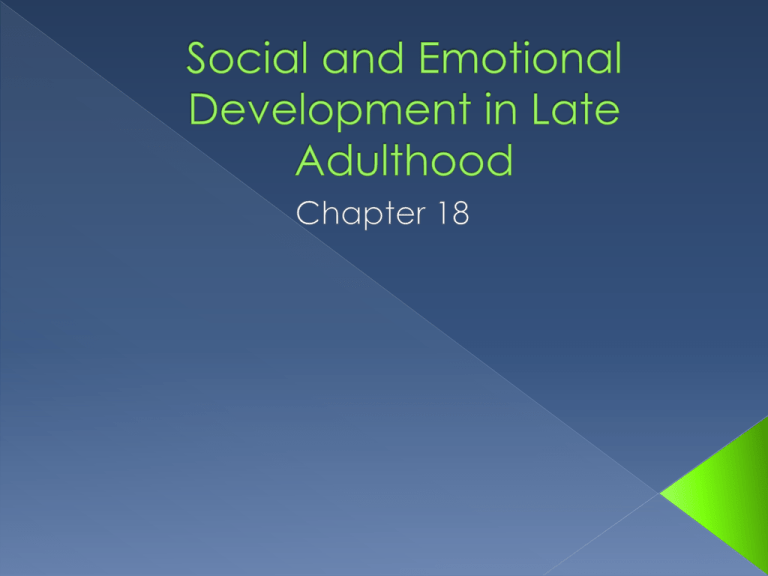Social and Emotional Development in Late
advertisement

The final psychological conflict of Erikson’s theory is ego integrity vs. despair › Involves coming to terms with one’s life Ego integrity › Adults who arrive at a sense of integrity feel whole and satisfied with their achievements, they have adapted to life’s triumphs and disappointments › The capacity to view one’s life in the larger context of all humanity contributes to the contentment that accompanies integrity Despair › Despair occurs when elders feel they have made many wrong decisions, yet time is too short to find an alternative › The despairing person finds it hard to accept that death is near and is overwhelmed with bitterness, defeat, and hopelessness › According to Erikson, these attitudes are often expressed as anger and contempt for others, which disguise contempt for oneself As with Erikson’s stages of early and middle adulthood, other theorists have clarified and refined his vision of late adulthood › Specifying the tasks and the thought processes that contribute to a sense of ego integrity All agree that optimal development involves greater integration and deepening of the personality According to Robert Peck, attaining ego integrity involves 3 distinct tasks Ego differentiation: for those who invested heavily in their careers, finding other ways to self-worth – through family, friendship, and community life › Body transcendence: overcoming physical limitations by emphasizing the compensating rewards of cognitive, emotional, and social powers › Ego transcendence: as contemporaries die, facing the reality of death constructively through efforts to make life more secure, meaningful, and gratifying for younger generations › Research suggests that body transcendence (focusing on psychological strengths) and ego transcendence (orienting toward a larger, more distant future) increase Joan Erikson, suggested that these attainments actually represent development beyond ego integrity (which requires satisfaction with one’s past) to an additional psychosocial stage › Gerotranscendence – a cosmic and transcendent perspective directed forward and outward, beyond the self Seen in heightened inner calm and contentment Elders improve in affect optimization – the ability to maximize positive emotions and dampen negative emotions › Which contributes to their remarkable resilience › They readily use emotion-centered coping strategies (controlling distress internally) in negatively charged situations Most older adults sustain a sense of optimism and good psychological well-being About 30%-40% of elders also retain a considerable capacity for cognitive-emotional complexity – a combination related to especially effective emotional self-regulation Older adults’ emotional perceptiveness helps them separate interpretations from objective aspects of situations In sum, a significant late-life psychosocial attainment is becoming expert at reflecting on one’s own feelings and regulating negative affect Reminiscence – telling stories about people and events from their past and reporting associated thoughts and feelings Current theory and research indicate that reflecting on the past can be positive and adaptive Life review – a form of reminiscence in which a person calls up past experiences, with the goal of achieving greater selfunderstanding Reminiscence often occurs during times of life transition, such as retirement or widowhood › Helps elders sustain a sense of personal continuity › Today, many elders in industrialized nations are largely present- and future-oriented, rather than focusing on the past and wishing to be young again But, many elders who are high in self-acceptance and life satisfaction spend little time evaluating their pasts Experts believe a new phase of late adulthood has evolved › The third age – spans ages 65-79, is a time of new goal setting, personal fulfillment, and high life satisfaction Longitudinal research reveals continuing stability of the “big five” personality traits from mid- to late-life Yet the ingredients of ego integrity – wholeness, contentment, and image of the self as part of a larger world order – are reflected in several significant latelife changes in both self-concept and personality Elders have accumulated a lifetime of selfknowledge, leading to more secure and complex conceptions of themselves Research indicates that the autobiographical selves of 65-85 year olds emphasize coherence and consistency Positive, multifaceted self-definitions are associated with psychological well-being › Hobbies, interests, social participation, family, health, and personality traits Most elders continue to mention – and actively pursue – some hoped-for selves in the areas of physical health, personal characteristics, relationships, and social responsibility Open-ended interviews and personality tests reveal that elders gain in agreeableness and show greater acceptance of change At the same time, elders show modest agerelated dips in extraversion and openness to experience Most older adults are resilient – especially if they were earlier in life Older adults’ general cheerfulness strengthens their physiological resistance to stress, enabling them to conserve physical and mental resources needed for effective coping Older adults may develop a more mature sense of spirituality Older adults attach great value to religious beliefs and behaviors › 72% of Americans age 65 and older say that religion is very important in their lives › At least in the U.S., elders tend to become more religious with age Involvement in both organized and informal religious activities is especially high among low-SES ethnic minority elders Involvement in both organized and informal religious activities is higher among women Both organized and informal religious participation is associated with longer survival Most adults adapt well to old age › Yet some feel dependent, incompetent, and worthless Personal and situational factors often combine to affect psychological wellbeing Identifying these contextual influences is vital for designing interventions that foster positive adjustment 2 predictable, complementary behavior patterns can be seen in observations of people interacting with older adults › The dependency-support script – dependent behaviors are attended to immediately › The independence-ignore script – independent behaviors are mostly ignored Both scripts reinforce dependent behavior at the expense of independent behavior Research shows that negative reactions to caregiving can result in persisting depression › When elders experience difficulty with daily activities, social contact is linked to a less positive everyday existence › This suggests that social interaction while assisting elders with physical care, household chores, and errands is often not rewarding but demeaning and unpleasant Whether assistance from others undermines wellbeing is a function of many factors › Including the caregiver-elder relationship and the social context in which helping occurs A stereotype of the elderly as passive and incompetent appears to be responsible for caregiver responses that promote excessive dependency in old age › Old people seem to be aware that people think they are feeble… and attribute their dependency to overresponsive social partners Dependency in old age can be adaptive if it permits older people to conserve their strength by investing it in highly valued activities › Ex. Mowing the lawn for grandpa so he isn’t too tired to go play golf Physical health is a powerful predictor of psychological well-being Physical declines and chronic disease can lead to a sense of loss of personal control › Which is a major factor in mental health More than actual physical limitations, perceived negative physical health predicts depressive symptoms › So how bad their health actually is, doesn’t matter as much as how bad they think their health is The relation between physical and mental health can become a vicious cycle › With each intensifying the other, as one goes down so does the other Elders generally do not get the mental health care they need-even in nursing homes, where mental health problems are widespread Negative life changes may evoke less stress and depression for older people than younger adults › Because elders have learned to cope with hard times and to accept loss However, when negative changes pile up, they test the coping skills of older adults › In very old age, such changes are greater for women than for men › Older women are more likely to be widowed, have lower income, and suffer from more illness In late adulthood, social support continues to reduce stress, thereby promoting physical health and psychological well-being › However, because many older adults place a high value on independence, they do not want a great deal of support from people close to them unless they can reciprocate Formal support as a complement to informal assistance spare elders from feeling overly dependent in their close relationships Ethnic minority elders do not readily accept formal assistance but are more willing to do so when helpers are connected to a familiar neighborhood organization, especially church For social support to promote well-being, elders need to assume personal control of it Besides tangible assistance, elders benefit from social support that offers affection, affirmation of their self-worth, and sense of belonging Extraverts continue to interact with a wider range of people than to introverts and people with poor social skills in old age Nevertheless, studies reveal that size of social networks and, therefore, amount of social interaction decline for virtually everyone This finding presents a curious paradox: › If social interaction and social support are essential for mental health, how is it possible for elders to interact less yet be generally satisfied with life and less depressed than younger adults Social theories of aging offer explanations for changes in elders social activity Two older perspectives, disengagement theory and activity theory interpret declines in social interaction in opposite ways More recent approaches, continuity theory and socioemotional selectivity theory, account for a wider range of feelings According to disengagement theory, mutual withdrawal between elders and society takes place in anticipation of death Older people decrease their activity levels and interact less frequently › Becoming more preoccupied with their inner lives At the same time, society frees elders from employment and family responsibilities › The result is viewed as beneficial for both sides Elders are granted a life of tranquility and once they disengage, their deaths are less disruptive to society However, not everyone disengages, and even when old people disengage, it may not be their preference › Rather it may be due to a failure of the social world to provide opportunities for engagement Activity theory states that social barriers to engagement, not the desires of elders, cause declining rates of interaction › When older people lose certain roles (retirement or death of a spouse), they try to find others in an effort to stay about as active and busy as they were in middle age In this view, elders’ life satisfaction depends on conditions that permit them to remain engaged in roles and relationships Problems with this theory › Activity theory fails to acknowledge any psychological change in old age Many studies show that merely offering elders opportunities for social contact does not lead to greater social activity › When health status is controlled, elders who have larger social networks and engage in more activities are not necessarily happier Apparently, quality over quantity applies here According to continuity theory, most aging adults strive to maintain a personal system – an identity and a set of personality dispositions, skills, and roles – that promotes life satisfaction by ensuring consistency between their past and anticipated future Participation in familiar activities with familiar people helps preserve physical and cognitive functioning and affirms identity Socioemotional selectivity theory asserts that social interaction does not decline suddenly in late age › Rather, it extends lifelong selection processes Physical and psychological aspects of aging lead to changes in the functions of social interaction › Elders emphasize the emotion-regulating function of interaction (approaching those who evoke positive feelings and avoiding those who evoke negative feelings) › And deemphasize other functions, such as information gathering (being friends with someone because they offer information you don’t have) In collectivist cultures, where people value an interdependent self, social relationships tend to not become restricted The physical and social contexts in which elders live affect their social experiences and, consequently, their development and adjustment Communities, neighborhoods, and housing arrangements vary in the extent to which they enable aging residents to satisfy their social needs Suburban elders have higher incomes and report better health than inner-city elders do Inner-city elders are better off in terms of transportation and proximity to social services › And are not as disadvantaged in health, income, and availability of services as those who live in small towns and rural areas Small-town and rural elderly compensate for distance from family and social services by interacting more with neighbors and friends Media attention has led to a widely held belief that crime against the elderly is common › Although older adults are less often targets of crime than other age groups However, I will say that this statistic came out before the big phone scam of last year… Fear of crime restricts activities and undermines morale among frail elders living alone and in inner-city areas › Ex. My grandparents are still trying to find a way to come visit me that doesn’t involve driving within 20 miles of Detroit or getting on an airplane… Elders housing preferences reflect a strong desire for aging in place – remaining in a familiar setting where they have control over their everyday life Ordinary homes › For the majority of elders, who are not physically impaired, staying in their own homes affords the greatest possible personal control › More elders in Western countries live on their own today than ever before, as a result of improved health and economic wellbeing › Older adults of Southern, Central, and Eastern European descent, as well as African Americans, Asian Americans, Hispanics, and Native Americans, more often live with extended families › During the past half-century, the number of unmarried, divorced, and widowed American elders living alone has risen dramatically Over 40% of them are poverty stricken Residential Communities › Housing developments for the aged differ from ordinary homes in that they have been modified to suit elders’ capacities › For elders who need more help with everyday tasks, assisted living arrangements are available Congregate housing – an increasingly popular long-term care option – provides a variety of support services, including meals in a common dining room, along with watchful oversight of residents with physical and mental disabilities Life-care communities offer a range of options, from independent or congregate housing to full nursing home care, guaranteeing that elders’ changing needs will be met in one place as they age › Studies of diverse residential communities for the aged reveal that they can have positive effects on physical and mental health › No U.S. federal regulations govern assisted-living facilities But physical designs and support services that enable aging in place are vital for elders’ well-being Nursing Homes › The 5% of Americans age 65 and older who live in nursing homes experience the most extreme restriction of autonomy and social integration › Potential social partners are abundant in nursing homes, but interaction is low › More homelike nursing homes could do much to increase residents’ sense of security and control The new Green House model offers aging-in-place features that ensure late-life well-being, such as physical and emotional comfort and meaningful relationships The social convoy is an influential model of changes in our social networks as we move through life › Ships in the inner circle represent people’s closest relationships (spouse, best friend, parent, child, etc.) › Those less close but still important travel on the outside › With age, ships exchange places in the convoy, and some drift off while others join the procession › As long as the convoy continues to exist, you adapt positively








